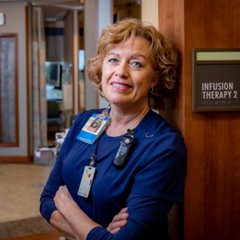Oncology Nurse Sees Breast Cancer From the Other Side

Kelly Huntey, RN, knows a lot about cancer. As an oncology nurse at Atrium Medical Center’s outpatient infusion treatment center for the past five years, she has cared for hundreds of patients who receive chemotherapy for cancer treatment. Her knowledge, however, didn’t prepare her for the emotions of discovering that she herself had breast cancer.
“My worst moments were everything before my treatment. Being on the patient side of the bed, I felt a loss of control. I am high strung, and my anxiety level was off the charts,” Kelly says.
A 3D mammogram in late March had shown a spot on her right breast. Kelly had fibrocystic breast disease, and she was used to having cysts and calcium deposits show up on her mammograms. What she hoped was just another calcium deposit turned out to be something more.
Her breast biopsy confirmed that at age 54 she had ductal carcinoma in situ, which means that cancer cells were lining the milk ducts of her right breast, although they hadn’t spread into surrounding tissue.
Kelly’s fellowship-trained breast surgical oncologist, Selyne Samuel, MD, FACS, gave her two clear options: have a lumpectomy and follow-up radiation therapy to prevent the cancer from coming back, or have a mastectomy to remove breast tissue in one or both breasts, with no follow-up radiation or chemotherapy.
“I’ve learned enough in my job to know what I wanted to do,” Kelly says. “Dr. Samuel has been fantastic. She’s very personable and warm, but also no-nonsense and direct. She gave me specific details and addressed even the small things. She told me I was going to live to be 96 years old.”
A Choice For Double Mastectomy
Kelly appreciated Dr. Samuel’s advanced training in breast surgery, as well as her in-depth knowledge of fibrocystic disease. The fibrocystic disease had been a source of pain and discomfort since her teen years, requiring needle aspirations to drain cysts over the years and painful breasts with her menstrual cycles.
She considered that getting a double mastectomy would relieve the pain and annoyance of her condition, as well as any lingering doubts that the cancer was really gone. She knew that due to her very dense breast tissue and grade of her cancer, a lumpectomy would mean twice-a-year monitoring of her remaining breast tissue, which she thought would heighten her own fears of a cancer recurrence.
Dr. Samuel comments, “Studies show that lumpectomy plus radiation, when the cancer is contained, is equal in outcomes to mastectomy. The patient does have a say. There are so many options, depending on a patient’s genetics, type of breast cancer, and preference.”
Kelly chose a nipple-sparing double mastectomy in early June at Miami Valley Hospital South. Dr. Samuel removed breast tissue and plastic surgeon Todd Hicks, MD, immediately started the reconstruction process by placing expanders under Kelly’s skin to replace the breast tissue.
“I prefer to do the combination surgery with the plastic surgeon, because patients are under anesthesia just once and have one hospitalization,” Dr. Samuel says. Regarding the nipple-sparing procedure, she says, “It’s technically difficult and not everyone is a candidate. It has better results for smaller-breasted women who have a good blood supply to the nipple. Kelly was a candidate and chose it more for aesthetic reasons. It makes many women feel more whole.”
As Kelly moved through the process from diagnosis to surgery, she received enormous support on several fronts. Her husband of 25 years, Dennis, was “fantastic. He doesn’t walk away from a crisis. He was very present. My mom lives two and a half hours away and came down and took care of me for two full weeks after the surgery.” Her daughter, Emma, was also on hand to help.
Kelly also received a boost from her colleagues and friends at Premier Health. “Nancy Thoma, the oncology nurse navigator, really helped my husband with a class on how to manipulate the drains put into each breast.” This increased his confidence about his role as a caregiver at home.
“My boss talked me off the ledge a few times,” Kelly continues, describing Debbie Gibson Hatter, MSN, APRN, FNP-BC, OCN. “She would ask how I was feeling about this. I received support from everybody at the infusion center. They took great care of me. They gave me a basket, a recovery bundle, filled with pillows and cushions and leg wedges. We’re like a family.”
New Perspectives
Kelly is feeling great these days. The fibrocystic pain is gone for good. She has no more worries about mammograms or needing a biopsy.
She returned to work after five weeks with a new compassion and appreciation for her patients. “I take a little more time and dive in a little deeper to listen to them talk about how they feel and the whole process of how it happened for them. It’s important to know someone cares about your life and your routine. They have other responsibilities in their lives — grandmothers babysitting grandkids or a husband needing care.”
She reflects on her own journey, saying, “When everything really came to fruition, I had to trust in someone other than myself. I needed to let go and let the professionals do their work.”
Leaning on family and friends didn’t hurt, either. “The best moments through all of this came from the support I had. I feel so grateful.”
Getting your mammogram is your first important step for breast health and to fight breast cancer. Schedule your mammogram online or call (855) 887-7364(855) 887-7364 Monday through Thursday, 7:30 a.m. to 7 p.m., or Friday, 7:30 a.m. to 6 p.m.


Contact Us
Call the Premier Health cancer hotline at (844) 316-HOPE(844) 316-4673 (4673), Monday through Friday, 8 a.m. to 5 p.m., to connect with a Premier Health cancer navigator.

